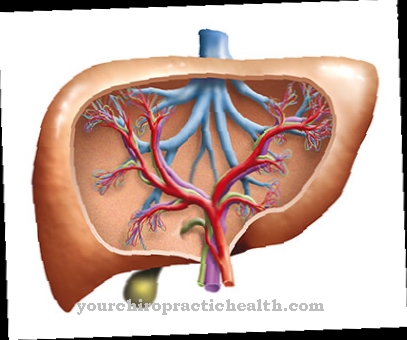The dissociative conversion disorder is a group of psychosomatic illnesses in which physical symptoms occur after a psychologically traumatizing situation. Diagnosis requires the exclusion of any diseases of organic origin that could explain the symptoms. Treatment is through psychotherapy and forms of behavioral therapy.
What is dissociative conversion disorder?

© Orawan - stock.adobe.com
Psychosomatic disorders are disorders that are purely psychological and cause physical symptoms due to the connections between the psyche and the body. Some psychosomatic disorders are transient, i.e. they are only temporary. Dissociative conversion disorder falls into this category.
The term is an umbrella term for different disorders that are associated with different symptoms. Although the symptoms can be more or less different from one another, they share one common characteristic. Instead of physical illness, a stressful event is the cause of all symptoms of dissociative conversion disorder.
Like all other psychosomatic disorders, the form of conversion disorder is shaped by the connection between mental processes or feelings and physical reactions. Tangible changes in morphology occur. Exclusion of physical illness is the most relevant condition for diagnosing any dissociative conversion disorder.
causes
In most cases, dissociative conversion disorders are based on psychological conflicts that the patient cannot cope with or can only with difficulty. The most relevant conflicts of this kind correspond to traumatic events. Such an event can be the death of a loved one, for example. In order to avoid additional stress, the person concerned unconsciously filters out the accompanying stressors.
Instead of dealing with the traumatic event, an apparent illness with psychosomatic symptoms is preferred. In principle, as part of this procedure, the person affected initially experiences a primary gain in illness. According to researchers, the fact that the patient maintains the physical symptoms for months or even years is primarily due to the increased attention that the person concerned receives from other people due to the apparent illness.
Patients with dissociative conversion disorder thus experience, in addition to the primary gain from illness, a secondary gain from illness, which unconsciously encourages them to maintain their symptoms.
You can find your medication here
➔ Medicines to calm down and strengthen nervesSymptoms, ailments & signs
The severity and manifestation of symptoms in the context of dissociative conversion disorder is extremely variable. Often there is a single symptom, such as partial amnesia. In still other cases, the patient's motor skills are impaired, seizures occur, or sensitivity disorders and even paresis manifest themselves. Amnesia is one of the leading symptoms.
Above all, the patient does not remember the causally stressful event. In addition to this phenomenon, dissociative stupor can occur, which affects posture, muscle tension and the ability to react to environmental stimuli. In addition to trance and states of possession, dissociative movement disorders can be present, above all a reduced movement or a coordination disorder up to ataxia, dystonia or myoclonia.
Dissociative seizures similar to epilepsy as well as sensory or sensory disorders of the skin, sight, hearing or smell are also symptomatic. In combination with conversion disorder, dissociative disorders such as Ganser's syndrome can be present. In addition, personality disorders or anxiety disorders often occur.
diagnosis
As a rule, the first step takes patients with dissociative conversion disorder to a neurologist. As part of the medical history or external history, the neurologist often rules out organic causes for the neurological failure symptoms. Only in the rarest of cases do the failures appear so real that imaging is ordered.
Once organic diseases have been ruled out, the suspicion of dissociative conversion disorder is likely if the symptoms are appropriate. For further diagnostics, questionnaires for self-assessment and external assessment can be used. Somatization diseases must be excluded from the differential diagnosis in order to make the diagnosis of a dissociative conversion disorder.
In addition, as part of the diagnosis, the traumatic experience that triggered the symptoms is ideally determined. The prognosis for those affected depends primarily on the time of diagnosis and the degree of chronification of the disorder.
When should you go to the doctor?
A doctor should be consulted as soon as physical and psychological irregularities develop. Medical support is required after a traumatic experience or in the event of problems in the interplay of body and psyche.
If there are sensory disorders or seizures, persistent malaise or loss of vitality, a doctor is required. If the daily private and professional obligations can no longer be fulfilled as usual because the general level of performance is reduced, a doctor should be visited.
With headaches, a diffuse pain experience, lethargy, listlessness and listlessness, there is cause for concern. Digestive system problems, large changes in body weight, and general weakness need to be investigated and treated. A doctor should clarify the symptoms if they persist for several days or weeks, and if they increase in intensity or extent. Disorders of concentration or attention, motor problems and coordination difficulties must be examined and treated.
Consult a doctor in case of fear, a feeling of fogging, changes in the muscles or personality. Social withdrawal, depressed mood, and persistent stress should be discussed with a doctor. If the symptoms arise after experiencing an intense and formative life event, it is advisable to work with a doctor or therapist.
Doctors & therapists in your area
Treatment & Therapy
Patients with dissociative conversion disorder are treated causally. This means that the therapist starts treating the cause of the disorder. As soon as the stress of the event is no longer perceived as stressful and the trauma has been largely overcome, the individual symptoms of the disease recede.
Symptomatic therapy would only treat the symptoms. Symptomatic therapeutic steps to alleviate the individual symptoms are available, for example, in the form of conservative drug treatments with substances such as benzodiazepines. The drug is a sedative that currently reduces the high levels of suffering of patients with dissociative conversion disorder.
In modern therapy, however, drug therapy is used at most as an accompanying measure, in order to make the patient's anxiety controllable until the cause is cured and thus to improve his current quality of life. The main focus of treatment for patients with dissociative conversion disorder is behavioral therapy, which enables the patient to reassess situations and their own behavior.
In psychotherapeutic conversations, attempts are also made to free the patient as early as possible from the self-inflicted isolation and to bring them back to reality. Otherwise the disorder could become chronic, which would require long-term treatment and make healing much more difficult.
Outlook & forecast
The prognosis of dissociative conversion disorder is considered unfavorable. Many patients experience several mental disorders that reduce the prospect of recovery. If the dissociative conversion disorder is diagnosed together with an affective disorder, an addiction, eating and personality disorder, the disease can be expected to progress over several years or decades. In some cases there is no healing.
The symptoms of dissociative conversion disorder can develop suddenly after a triggering event and also regress completely in the further course. However, permanent relief is often not given. When experiencing a new life-critical event or dealing with repressed traumatic circumstances, the complaints reappear. These can differ in their scope and intensity from the known complaints.
Basically, a late diagnosis leads to a less favorable prognosis. For patients who do not experience any healing of the symptoms, the aim of treatment is aimed at integrating the complaints into everyday life. The decision on the therapy goal depends on the cause of the conversion disorder and the personality of the patient.
Through the integration, an overall improvement in well-being is achieved, since dealing with the disease is developed and trained in behavioral therapy. The person concerned learns how to react well to situations in life and the needs of his body.
You can find your medication here
➔ Medicines to calm down and strengthen nervesprevention
Dissociative conversion disorder can be prevented by prophylactically dealing with psychologically stressful situations and trauma accompanied by a specialist.
Aftercare
Follow-up care for this disease is very difficult in most cases. The illness must first and foremost be comprehensively examined by a psychologist and also treated, whereby there cannot be a self-healing. The earlier this conversion disorder is detected, the better the further course will usually be.
For this reason, early diagnosis of conversion disorder is important. It is also important that family members or friends also deal with this disease and inform themselves about the symptoms and their effects. They can only help those affected if they have a thorough knowledge of the disease.
Intensive and above all loving discussions with the person affected are very important in order to alleviate the symptoms. In many cases, patients with conversion disorder are also dependent on taking medication. It is important to ensure that the dosage is correct and that it is taken regularly. In the case of serious complaints, the relatives can persuade the person concerned to seek treatment in a closed institution. Typically, this disease does not reduce the patient's life expectancy.
You can do that yourself
Since dissociative conversion disorder is a psychological disorder, the possibilities for self-help for those affected are very manageable. One of the symptoms of the disease is the lack of insight into the disease. It is not possible to change one's thoughts and actions on one's own initiative so that relief can occur. Therefore, the person concerned should seek professional help.
Once the diagnosis has been made, it is a good idea to have extensive information about the progression of the disease. Through the educational work, changes and improvements can be achieved. Since people from close social circles are often directly confronted with the patient's complaints, these people should also inform themselves sufficiently about dissociative conversion disorder.
The knowledge of the characteristics of the mental disorder helps all those involved in the immediate environment in everyday life to avoid conflicts. The understanding of the behavior shown increases and it becomes more comprehensible for relatives or friends. Personal emotional injuries diminish once the disorder is learned to deal with.
Despite all adversities, a stable social environment is important for maintaining life satisfaction. For this reason, an open approach to the mental disorder is recommended. Withdrawal behavior is not conducive as it causes further problems.




.jpg)
.jpg)
.jpg)






.jpg)

.jpg)











.jpg)